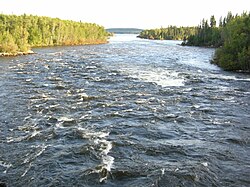
This is a list of rivers of Saskatchewan , a province of Canada.
Contents
- Principal river statistics
- Rivers by drainage basin
- Alphabetical list of rivers
- A
- B
- C
- D
- E
- F
- G
- H
- I
- J
- K
- L
- M
- N
- O
- P
- Q
- R
- S
- T
- U
- V
- W
- Y
- Z
- See also
- References
The largest and most notable rivers are listed at the start, followed by rivers listed by drainage basin and then alphabetically.





